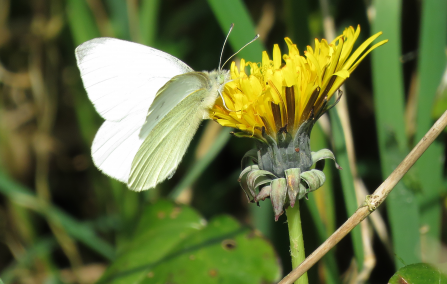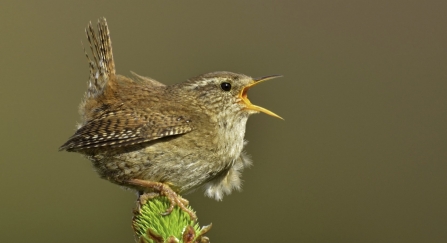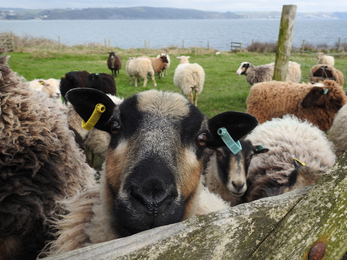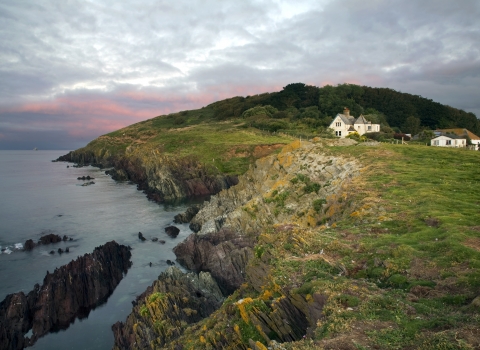We had to read George Orwell’s Animal Farm when I was at school. Do you remember the slogan “Two feet baaaaa…d, four feet good”? And how at the end of the book it changes to “Four feet good, two feet better”? Hmm, anyway I thought of that as I was watching some of our mischievous Shetland Sheep. They were standing on their hind legs so that they could eat the leaves from the trees. I wasn’t sure if it was funny or just disturbing… I hope they aren’t planning a rebellion!
The teeny weeny stuff
Now, don’t giggle at the name but we’ve seen our first Cockchafers of the year. They are big and they buzz – what’s not to like? Big, brown bumbling beetles that seem to just clumsily bounce into everything. Being so large and noisy means they bring a lot of attention to themselves and leads to lots of local names. I think Doodlebug, Spang Beetle and Humbuzz suits them well. Oh and Maybug too – as that’s when lots emerge from underground.

Cockchafer by Claire Lewis
In fact these beetles spend most of their life underground. The first two to three years are spent in the soil. To be honest, being ugly fat white larvae it might be best that they stay hidden underground. These juicy grubs eat their way through lots of plant roots. Once mature they emerge in the Spring as bulky, clattering beetles. As an adult they only live for around six weeks. Apart from nibbling a few leaves the male has just one thing on its mind – to find a mate. Being nocturnal means that this could be tricky but they have a cunning trick. They fan out their amazing antler like antennae to ‘smell’ the pheromones of a female. Once they’ve found each other it’s more beetle bumbling as they get together to produce a batch of eggs. The eggs get laid in the soil and the cycle then begins. What a strange life.
It’s been a bit quiet on the butterfly front… except perhaps for a few more flittering Small Whites.

Small white on dandelion by Claire Lewis
These pretty little things get a bad press. They get lumped together with the Large White butterflies and are unfavourably called ‘cabbage whites’. It’s because their hungry caterpillars munch through the brassicas in vegetable patches and farmer’s fields. All very frustrating. The female Small White butterfly might just lay one egg on the underside of a leaf and within a week it’ll hatch into a munching machine, eating the heart out of a cabbage – not very considerate at all.
Now a fascinating fact that I learnt from my copy of Thomas and Lewington’s Butterflies of Britain and Ireland is that when Small White butterflies mate the male transfers two types of sperm to the female - how generous! One is a type of sperm that fertilises the egg and the other is a nutrient package to boost the female before she lays her eggs, and it’s called a ‘nuptial gift’ – how very sweet and thoughtful.
The greeny stuff
Surely one of the most cheerful wild flowers that we get here is a pea. It’s the Bird’s-foot Trefoil pea. Every year I look forward to finding clusters of its bright golden yellow and orangey red flowers amongst the grassland.
Bird's-foot trefoil by Claire Lewis
Like the Cockchafer this plant has lots of common names. I used to call it Eggs and Bacon (yum!) but I now think Bird’s-foot Trefoil suits it better. Why? It’s because of its seeds. Later in the year it’ll produce claw like seed pods which splay out just like a bird’s foot. The best bit about this plant is how it spreads out it seeds. It uses the blasting bomb technique. You see, as the long seed pods dry out, they twist and contort until they burst. It’s a sudden explosion of baby peas! What a dramatic entrance to the world. Oh and I should add that bees and butterflies such as the Common Blue think this plant is marvellous too as they are drawn its super supplies of nectar and pollen.
Rowan (Mountain Ash) blossom is very romantic, isn’t it? It looks all soft and fluffy around the edges.
Rowan blossom by Claire Lewis
Rowans have lots of connections to folklore and mysticism. If you plant it by your house it’s said to keep evil spirits at bay. We’ve planted this elegant tree around the island, not to ward off witches but to bring in the birds.
Right now Rowan is looking a treat with its delicate creamy flowers but it’ll be wonderful in the late summer/autumn as well. That’s when it’s dangling bunches of brilliant red berries will be a feast for birds like thrushes. And here’s a fascinating fact… this tree’s latin name is Sorbus Aucuparia. Not that interesting but wait, aucuparia means ‘bird catching’ and in the past people would use these berries as bait for birds! Not nice, but crafty, eh? Still it shows just what an irresistible tree it is.
The feathery stuff
So, I can’t hold off any longer, it’s time to bring in the big gulls.
I’m talking Great Black-backed Gulls. These magnificent gulls are massive. They have a wing span of just over 1.5m, a chunky body and a powerful bill, and maybe you guessed… they are the world’s largest gull.
Great black-backed gull by Claire Lewis
Though I’m not sure they are the most endearing of gulls. You see they have the unfortunate habit of using their size to bully other birds. Think of them as being a bit like an intimidating pirate, only rather than treasure they ruthlessly steal food off other birds.
There’s a big breeding colony of them here too. Now, there’s a bit of ‘friendly rivalry’ over these birds between us and Mullion Island. It’s all about the numbers. How many are here vary from year to year, but I’ll put it out there, it is usually Looe Island that holds Cornwall’s largest breeding colony of Great Black-backs. So there, we are top place! Next week we’ll do a nesting seabird count so can properly check the numbers. Usually we have around 80 pairs – wish us luck – hope we are still able to claim that title.

Great Black-backed Gulls on main beach by Claire Lewis
Having talked about a big, regal bird I think we should move on to one of the island’s smallest breeding birds. It’s the Wren. Officially Britain’s most common bird, they are everywhere. There’s never been an island survey of their numbers but I’m sure we’d have the largest breeding colony of these diddy birds too.

Wren - Andy Rouse
With a wren it’s their voice you notice first – for such a small birds, it must have one of the loudest, fastest and shrillest of songs. Have you ever watched one blast out a tune? It can sometimes look like their whole body is trembling with the effort. In fact they can even produce two notes at the same time – go little wren, go!
The salty stuff
Now, everyone knows about starfish but have you heard of a brittlestar?

Brittlestar by Claire Lewis
Brittlestars are related to starfish but instead of moving with tubed feet they move with Inspector Gadget like long arms. Some have arms they like colourful stripy candy bars but the one I found was a plain creamy colour. It’s easy to find them around the island’s coast and they really live up to their name. Those five long and spiny arms are very fragile and easily break off. In fact if they feel threatened they’ll shed one of these limbs – drastic measures, eh? But the best things about brittlestars is that they don’t have a bum. What no bum? Nope, no bum. Instead any waste just goes out the way it came it … through their mouth! Yuck!
This week we’ve mainly been seeing seals sleeping. Regulars, Duchess and Snowdrop even put on a synchronised sleeping display:
Duchess and Snowdrop sleeping by Claire Lewis
In a previous blog I mentioned how sleeping upright in the water like this is called bottling but Snowdrop usually prefers ‘logging’. Yep – she likes to sleep floating horizontally at the surface of the water like a…, well, a log.
Grey seal logging by Claire Lewis
Seals can spend hours out there logging. They each seem to have their own logging style. Some arch their heads back to help them breathe at the surface; others seem to really make a big deal of opening and closing their nostrils to breathe in air and keep water out. When I see them sleeping at the surface and hear them making funny gurgling noises and blowing bubbles it always makes me smile. It’s also really rather relaxing to watch a seal logging and can make you also feel very, very sleepy… zzzzzzzzzzzzzzzz.
Coming soon...
Expect to read about:
- Cormorant carry ons
- Blooming Sea Pinks
- More mighty moths
Rockpool by Claire Lewis


